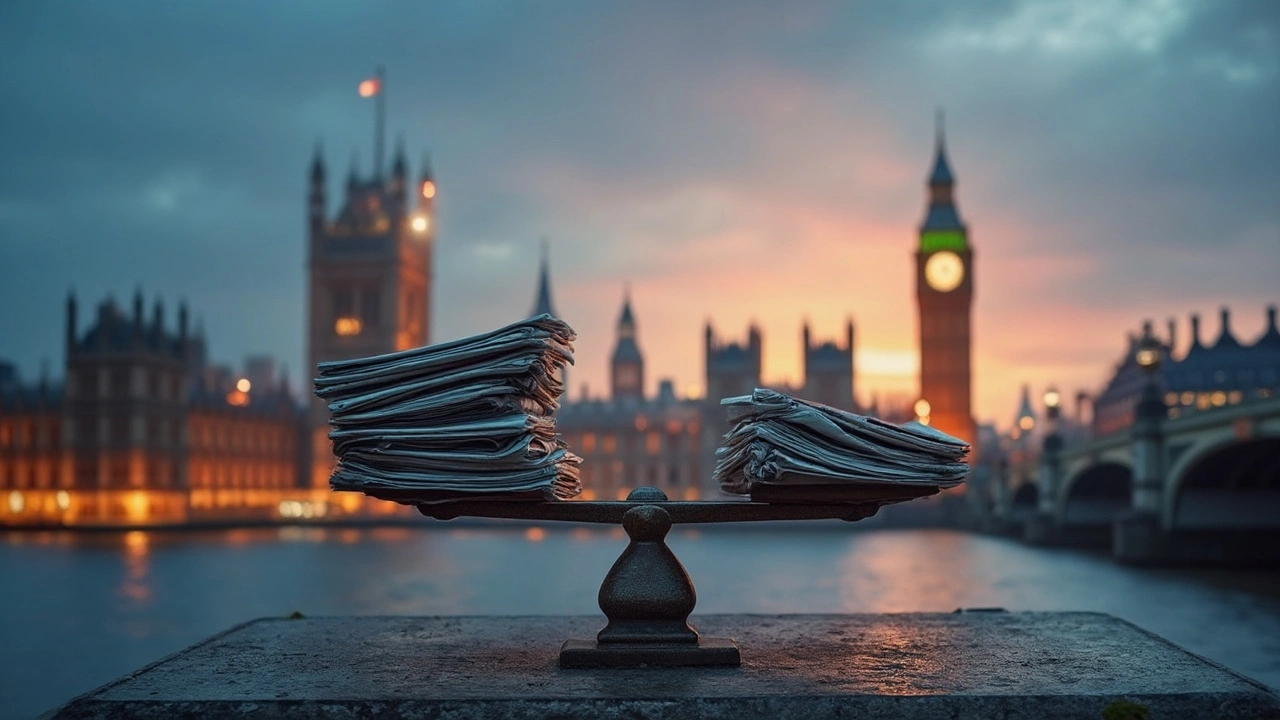
Diving into the world of news can be a bit like unraveling a mystery. Is that headline running across your social feed unbiased, or has it veered off into partisan territory? Figuring out the political slant of a news source, such as The New York Sun, isn't as straightforward as it seems. But worry not, because we've got some nifty alternatives to give you a better grasp of where news outlets might stand on the political spectrum.
First on our list is 'News Source Political Agenda Identification'. This approach takes a peek at whether a news outlet is waving the flag for specific political agendas or policies.
Pros
- Reveals advocacy-driven content, shining a spotlight on potential biases.
- Helps in detecting partisan narratives, whether they lean left, right, or perhaps somewhere in between.
Cons
- Might sometimes mistake neutral reports as being agenda-driven.
- Doesn't always account for purely factual news with no hidden motives.
- News Source Political Agenda Identification
- Content Analysis for Ideological Signals
- Audience Demographic Analysis
- Ownership Influence Examination
- Journalistic History Review
- Expert Opinion Synthesis
- Social Media Trend Analysis
- Content Sponsorship Scrutiny
- Conclusion and Summary Table
News Source Political Agenda Identification
When it comes to understanding if a news outlet has a political bias, analyzing the agenda it might be pushing is a smart move. Essentially, this means taking a close look to see if the outlet is actively championing specific political ideas or policies.
Why does this matter? Well, news outlets sometimes wear their political hearts on their sleeves. By focusing on the agendas they promote, readers can get a better idea of any underlying media bias. Are they pushing for policy changes or aligning with particular political movements? Recognizing these can help in spotting a clear political slant.
For example, if an outlet has a pattern of publishing content advocating for stricter environmental regulations, it might be leaning towards a more left-leaning or progressive stance. Similarly, if another outlet is consistently promoting tax cuts for corporations, this might indicate a right-leaning perspective.
How To Spot It
- Examine recurring themes in their content – Look for topics they cover a lot and think about the angle they're presenting.
- Analyze opinion pieces and editorials – These often break cover on an outlet's political leanings.
- Check affiliations and partnerships – An outlet might have relationships with certain advocacy groups.
This method shines when it comes to picking up on clear biases but can also have its pitfalls. Sometimes neutral reporting might be mistaken for something agenda-driven, which is a common error when applying this approach. It's essential to remember that news analysis is complex and one size doesn't fit all.
Content Analysis for Ideological Signals
When it comes to figuring out whether a news source has a political bias, doing a deep dive into its content can give some insights. By looking out for certain ideological signals, you can get a better grip on how a news outlet might be leaning.
Picture this: a headline uses the phrase 'unconstitutional regulation'. That's a pretty good cue that the content might have a certain bend to it. This is what's known as Content Analysis for Ideological Signals. By examining the language, tone, and themes in news articles, you can see if they're subtly promoting a particular viewpoint.
Pros
- Helps in identifying keywords or phrases that suggest political leanings.
- Spotlights how repetitive use of certain terms (like 'freedom' or 'equality') might indicate a bias.
Cons
- Content can be cryptic, leaving room for interpretation which might not always be accurate.
- Takes time and isn't foolproof—sometimes the signals are just unintentional word choices.
Did you know? A study by the Pew Research Center in 2021 found that certain terms, such as 'climate crisis', tend to show up more in left-leaning media outlets, whereas phrases like 'job creators' are more common in right-leaning sources. These types of patterns are what content analysis hones in on.
This method doesn't just rely on gut feeling; it involves a bit of detective work with actual text analysis. The key is picking up on patterns and repetitions that signal ideological tilt, without jumping to conclusions too hastily.
Audience Demographic Analysis
Wanna get a grip on whether a news outlet leans left or right? Checking out who's actually consuming their content can give you a world of insight. Audience Demographic Analysis is kinda like peeking through the window into a media outlet’s living room, to see who’s hanging out.
This method takes into account the age, income level, education, ethnicity, and other factors among the audience. You find patterns—like are the readers mostly young, and city-based, or a bit older, living in the suburbs? These insights can fetch clues about the political slant of the publication.
The Pew Research Center states, "Media outlets' audience profiles reveal stark ideological divides. Only 30% of those with a college degree prefer outlets from which they perceive a conservative bias."
Let’s think about this: if the majority of a news outlet's audience are urban young professionals, the coverage might skew towards progressive or liberal ideologies. But, if the die-hard fans are mostly retirees, maybe that content leans towards conservative viewpoints. It’s a generalisation, sure, but a useful one!”
On the flip side, this method can have its downsides because demographics don’t tell the whole story. Not everyone in the same age or income group thinks alike.
Pros
- The approach adds a layer of understanding by linking reader preferences with content slant.
- Great for drawing connections between media consumption habits and demographic characteristics.
Cons
- It’s a bit tricky because it relies on assumptions that might not always hit the mark.
- Can't fully grasp individual opinions and how they might influence the perceived bias.
Interestingly, news platforms often adapt based on changing audience demographics. As younger generations become politically active, their values may shape media narratives differently, complicating simple left or right definitions.
Ownership Influence Examination
Ever thought about who owns the newspapers you're reading or watching? It can be a really big deal. Owners can have a knack for weaving in their own political bias into what gets published. Let's break this down.
Take Rupert Murdoch, for example. His company, News Corp, has vast media interests across the globe, including right-leaning outlets like Fox News in the States and The Sun in the UK. Such ownership can often tilt coverage towards certain political views or candidates, not just in one story, but across a whole slate of programming or articles.
Here’s the kicker: sometimes it's subtle. According to studies, about 30% of the public believes media owners influence news content directly. But, it’s not always about blatant headlines. Instead, it can come down to what stories are chosen, how they’re framed, or which voices are featured.
Now, how can you as the reader become savvy? Easy! Here are a few tips:
- Look up the ownership structure of the media outlets you follow.
- Research past political donations by media owners or parent companies.
- Compare news from outlets with different owners to spot potential biases.
Pros of Ownership Influence Examination
- Helps uncover potential media bias at the source.
- Offers insights into how ownership interests may shape editorial decisions.
Cons of Ownership Influence Examination
- Requires time and effort to research ownership and influence links.
- Can't always reveal subtle or indirect influences that don't leave a clear trail.

Journalistic History Review
Ever think about where a newspaper’s story really begins? It’s not in today’s headlines or yesterday’s updates, but deep in its history. Yep! The past can tell you loads about whether a news outlet has a left or right lean. Let's break it down.
Digging into a paper's past isn't just museums and archives kind of stuff. It’s about understanding patterns, styles, and choices that've been consistent over the years. Newspapers like The New York Sun, for instance, have been around the block. Knowing how they’ve reported major political events can give you hints about their leanings.
Understanding the Patterns
Check this—a lot of old-school newspapers stick to their guns. If they were supporting a specific party or viewpoint years back, there's a good chance they still are. It's like finding your granddad's vinyl collection and realizing you two share the same taste in tunes.
Examining how outlets have approached pivotal events or shifts in the political landscape can be very telling. For instance, how did they cover the Vietnam War or the fall of the Berlin Wall? Did they side with the government or take a 'power to the people' approach?
Spotting Changes Over Time
Sometimes, though, a newspaper might surprise you. Their past might show a steady rightward slant, but in recent years, they might've taken a hard turn to the left or vice versa. By keeping tabs on such shifts, you can see if they’re running after changing audience tastes or sticking to core principles.
Analyzing the evolution in editorial tones or changes in ownership can also offer a clue. For instance, a significant change in ownership might bring about a shift in political slant.
| Event | Historical Approach |
|---|---|
| Vietnam War | Government Support |
| Fall of the Berlin Wall | Power to the People |
| Recent Economic Policies | Editorial Shifts |
So, if you want to uncover if a news source like The New York Sun (or any other) is flipping left or right, start with the paper trail they’ve left over the years. It’s like reading between the lines, but with history as your guide.
Expert Opinion Synthesis
Ever thought about how much experts' opinions shape what we perceive about news outlets and their political biases? When it comes to understanding if news sources like The New York Sun are swayed one way or another, expert opinion synthesis can be a game-changer. This basically involves gathering insights from seasoned analysts, media critics, and academic experts to offer a more grounded view of the outlet's political leanings.
Experts bring a wealth of knowledge, often evaluating years of reporting, the tone of articles, and even editorials. They can identify subtle biases that a casual reader might miss. This isn't just a hunch; it's backed by their background and knowledge of media dynamics.
Pros
- Access to informed perspectives that are often backed by research or years of experience.
- Experts can spot nuanced shifts in reporting trends that indicate a political bias.
Cons
- Opinions can sometimes differ, leading to a lack of consensus among experts.
- May lead to overdependence on selected viewpoints without considering broader data.
To illustrate, imagine you have two experts: one thinks an outlet has turned more to the left over the years, while another insists it's maintained objectivity. That can be a bit frustrating, right? But the real value lies in comparing these views and forming an averaged perception.
| Expert Name | Background | Opinion |
|---|---|---|
| Dr. Kelly Barnes | Media Studies Professor | Leans slightly right |
| Mark Thompson | Political Analyst | Remains neutral in reporting |
While you might not always get a black or white answer, synthesizing expert opinions offers a broader and deeper understanding of media biases. It's an integral piece of the puzzle when it comes to navigating the complex landscape of modern news.
Social Media Trend Analysis
Ever feel like social media is setting the agenda for your daily news updates? You're not alone. Social media trend analysis can be an eye-opener in understanding a news source's political bias. It’s all about checking out what’s trending and how it lines up with the narratives pushed by certain news outlets.
Platforms like Twitter and Facebook have become unofficial news hubs, where algorithms decide the news we see based on what’s popular, not necessarily what’s important. By tracking these trends, we can figure out if an outlet, like The New York Sun, is picking up stories that skew toward certain political ideologies.
Pros
- Lets you tap into public sentiment, giving you a sense of which way the political winds are blowing.
- Helps identify the focus and bias of news outlets by observing which stories gain traction under certain tags or discussions.
Cons
- Not all trends reflect authentic news—they could be spurred by bots or organized efforts.
- Trends may favor sensationalism over substance, skewing perceptions of bias.
To make things clearer, here's a little example table showing the potential impact of trending topics on news bias.
| Trending Hashtag | Potential Bias Indication |
|---|---|
| #ProgressiveAgenda | Possible left-leaning bias |
| #TaxCutWins | Possible right-leaning bias |
Keeping an eye on what’s trending and identifying patterns in the type of content shared can shed light on an outlet's slant. Social media trend analysis isn't a surefire method, but it’s a handy tool in the toolbox when deciphering the biases behind news stories you encounter.
Content Sponsorship Scrutiny
Ever wondered how those flashy ads and sponsored segments on news platforms impact the news itself? That's where Content Sponsorship Scrutiny comes in. In this section, we dig into how sponsorships might sway the slant of news articles. The idea is to see if sources are giving preferential treatment to sponsors, subtly weaving biased views with their financial backers in mind.
Brands and organizations often sponsor content to get their narrative out there, so it’s important to keep an eye on who's funding whom. This doesn't just mean outright ads either; think about a feature article that subtly favors the opinions or interests of a brand.
Pros
- Spotting such influences helps consumers discern between genuine content and advertorial spin.
- Helps hold media accountable for transparency in their funding sources.
Cons
- Not all sponsorships are nefarious; some outlets maintain integrity despite financial ties.
- Can sometimes lead to paranoia, where folks see hidden agendas everywhere, impacting media trust unfairly.
Famous examples include the relationships between some major news outlets and big companies, where sponsorship deals might subtly guide the tone or substance of coverage. While it’s not always about pulling strings, the potential for undue influence is enough reason for scrutiny.
So, next time you see a brand's name pop up alongside a headline, it might be worth checking what’s really being sold – the product or the story?

Conclusion and Summary Table
So, there you have it—a whole bunch of ways to get a grip on the political slant of your news sources, including that infamous question about The New York Sun's leanings. We're not just talking about taking a wild guess here. These alternatives let you dive deeper into the nuts and bolts of what drives news coverage in terms of political bias and media bias.
From identifying political agendas to checking ownership influences, each method brings its own strengths and weaknesses to the table. Some are great for spotting obvious partisan content, while others peel back the layers of editorial influence and corporate meddling.
Taking Stock: What's What
To wrap things up nicely, here's a quick look at how each alternative stacks up:
| Method | Key Feature | Pros | Cons |
|---|---|---|---|
| News Source Political Agenda Identification | Focuses on driven-policy content | Reveals biases | May misjudge neutral reporting |
| Content Analysis for Ideological Signals | Looks for specific languages or topics | Catches subtle signals | Might be subjective |
| Ownership Influence Examination | Considers the owners' backgrounds | Shows potential influences | Not always transparent |
| Audience Demographic Analysis | Analyzes audience's political tendency | Reflects target audience | Relies on available data |
| Journalistic History Review | Examines prior works | Patterns of bias revealed | Time-consuming |
| Social Media Trend Analysis | Monitors sharing patterns | Real-time updates | Short-lived data |
| Content Sponsorship Scrutiny | Investigates funding sources | Exposes financial bias | Details may be hidden |
Each method has its role to play in understanding political biases. Whether you're dissecting a news article or scrolling through your morning updates, knowing the leanings can help you digest information more critically. Remember, while these methods aren't a magic bullet, they’re pretty effective tools to add to your media toolkit. Go ahead and give them a whirl with your next news source investigation—it could be a real eye-opener.